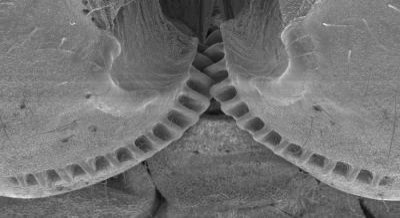‘Mechanical Gears’ Found In Nature: Planthoppers Use ‘Cogs’ To Jump
Researchers have discovered, for the first time, “mechanical gears” in nature. Juvenile planthoppers use a set of interlocking teeth, similar to cogs, to coordinate their legs as they jump.

Researchers from the University of Cambridge discovered this mechanism in juvenile Issus, a type of planthopper commonly found in Europe. Scientists had previously believed gears belonged to the domain of man-made inventions but the rotating teeth found in the hind legs of these young insects proves otherwise.
Co-author Gregory Sutton, now at the University of Bristol, said in a statement, "We usually think of gears as something that we see in human designed machinery, but we've found that that is only because we didn't look hard enough," he continues, "These gears are not designed; they are evolved - representing high speed and precision machinery evolved for synchronization in the animal world."
According to the researchers, cogs, or wheel designs, have been found in nature but are not functional and are ornamental. Wheel bugs have a cog-like design as part of their thorax armor while the “cog-back turtle” gets its name from the sharp teeth found along its shell.
As nymphs, young planthoppers have these gears as a way to synchronize their legs during propulsion. The gears on one leg, as it prepares to jump, cause the other leg to move as well which allows for a successful jump. Without these gears synching up the insect’s movement, the planthopper could spiral out of control.
The gears have a 1:1 ratio, and each leg features matching sets of 10 to 12 teeth. There is another ingenious aspect found in the design of the gears of the planthopper. Each tooth is rounded off, similar to the design of a bike chain, reducing the possibility of damage to these gears, notes the University of Cambridge.
According to Malcolm Burrows, from the University of Cambridge, the gears allow the nymphs to jump, as relaying signals in the insect’s nervous system would take too long and would require almost perfect coordination to achieve. "By developing mechanical gears, the Issus can just send nerve signals to its muscles to produce roughly the same amount of force - then if one leg starts to propel the jump the gears will interlock, creating absolute synchronicity," said Burrows.
The nymphs eventually lose these gears as they become adults, during the last molting phase. The scientists believe the gears found in nymphs, if damaged, can be repaired during the next molt but adult planthoppers cannot molt and repair any potential damage to these gears. Another possibility is the increased size of the insect and their fully-formed "trochantera," the insect version of a femur, allows for the necessary friction to propel these insects, notes Cambridge.
Burrows and Sutton had previously solved the mystery of how fleas jumped. Using a similar process involving high-speed cameras, the duo discovered fleas use their toes for flight, with the insect's tibia acting as lever pushing down on the toes, equipped with gripping claws for traction, creating the force necessary to jump.
The research was published in the journal Science. A video of the mechanical gears of the juvenile planthopper in action can be viewed below.
© Copyright IBTimes 2024. All rights reserved.






















